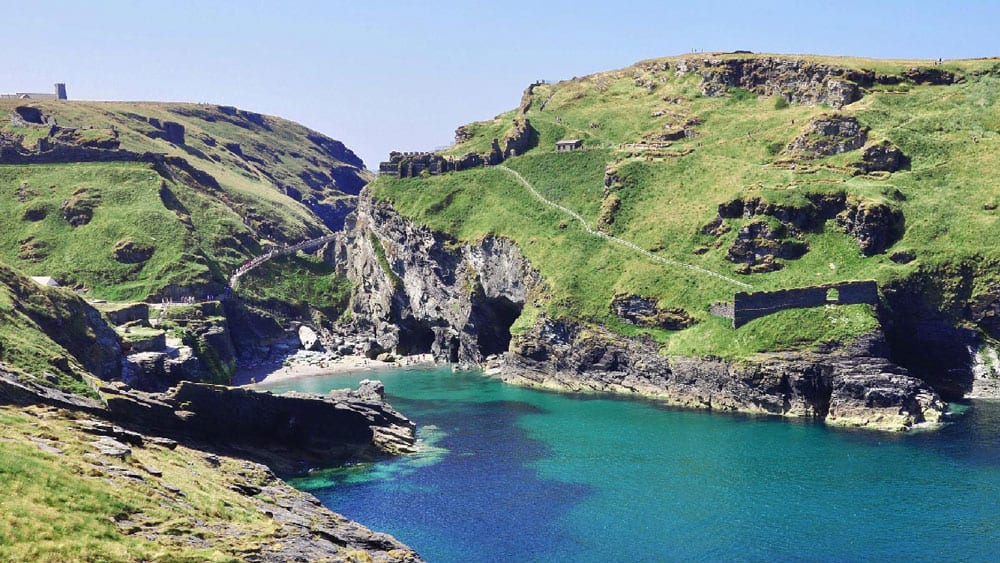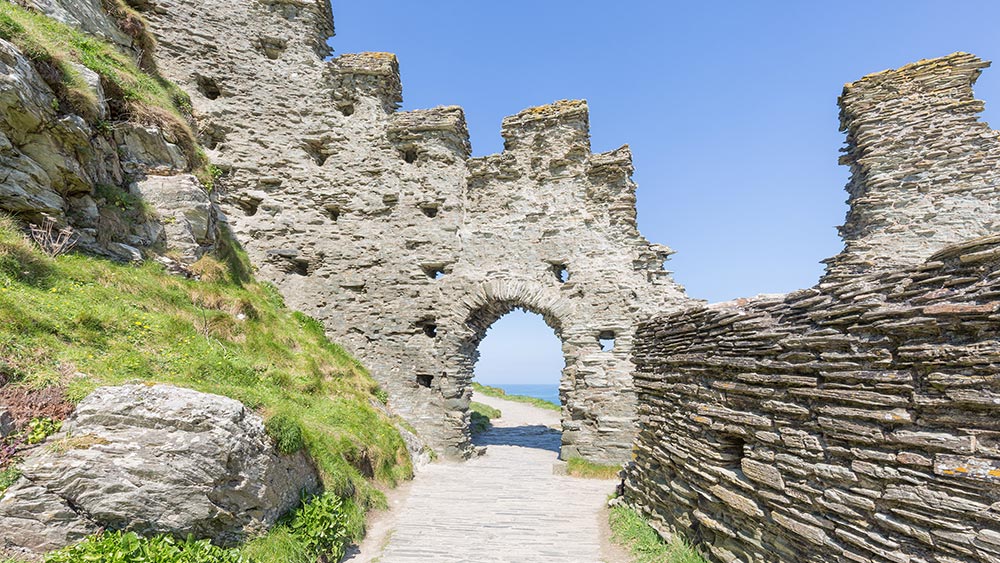Tintagel Castle and the Legend of King Arthur
Delving into Tintagel’s Arthurian Past
Join us on a tour of one of Cornwall’s most mystical ruins as we travel through the mists of time…
You couldn’t find a more dramatic location; perched on the sweeping clifftops of North Cornwall, where wild, grassy slopes tumble towards rugged sheers and the thundering swells of the Celtic Sea pound the bluffs while seabirds ride the squalls.

Every year, thousands of visitors travel the coastal road to the characterful parish of Tintagel seeking out the famous castle ruins that command its headland. It’s beneath these tumbled down keeps and courtyards and along these secret winding passageways that the legends of Tintagel still echo, from the romantic sagas of King Arthur to the magic and sorcery of Merlin the enchanter.
Tintagel Castle came to prominence as a fortress for medieval Cornish chieftains, its attachment to Arthurian legend forged by the historian and chronicler, Geoffrey of Monmouth, who was the first to suggest that this towering stronghold was the birthplace of King Arthur within the pages of his magnum opus Historia Regum Britannae. From his epic dual with his arch nemesis, Mordred, his wielding of Excalibur ‘Sword in the Stone’, his Knights of the Round Table, his epic battles with monsters and dragons, his quest for the Holy Grail, Arthurian legend remains inextricably linked to the southernmost realms of Cornwall.
A 1,500-year-old slate tablet is believed to add credence to King Arthur’s presence in Tintagel and suggests he was a descendant of King Coel, a figure also embedded into Cornish folklore but perhaps more widely recognised as ‘Old King Cole’ the ‘merry old soul’ in the popular children’s nursery rhyme. Furthermore, some of the mythical descriptions of Camelot – Arthur’s castle and court – fit the dramatic setting of Tintagel, however, the castle ruins only date back as far as the early 1200s when it was built under the instruction of Richard, 1st Earl of Cornwall, himself an admirer of Arthurian legend.

Among the many works of art to be admired when you roam this captivating coastal enclave is the life-sized bronze sculpture inspired by King Arthur and his chivalric code and noble past. Created by artist Rubin Eynon, the statue is called ‘Gallos’, the Cornish word for ‘power’, and stands upon the cliff edge having been lifted into place by helicopter, such is its size and weight.
The battlements and ramparts of Tintagel Castle are also the stage for one of the Middle Ages’ most fervid love stories, that of Cornish knight Tristan and Irish princess Iseult, a romance many believe to be reminiscent of the forbidden union between Sir Lancelot and Lady Guinevere, an ill-fated love affair that would divide the Round Table.
Follow the cliff path down to the shores below the castle to discover Merlin’s Cave, a hollow stretch that passes under Tintagel Island connecting Tintagel Haven to West Cove. This spectacular sea cave became the inspiration for poet Alfred Tennyson and features in his collection of Arthurian poems entitled Idylls of the King, Tennyson capturing a scene where Merlin rescues the bairn Arthur from the crashing waves, carrying him ashore to safety. The sandy floors of the sea cave can be explored at low tide, the cave itself carved out by centuries of ocean erosion. More recently, the profile of Merlin has been sculpted into the rockface in recognition of both his legend and his connection to these sacred shores.
Building Bridges: Reuniting Tintagel Castle…
The latest exciting chapter in Tintagel’s colourful history saw the much-anticipated opening of the new footbridge, allowing visitors to trace the path of those who walked the once narrow, naturally-formed land bridge that linked both wings of the castle some five hundred years ago before succumbing to the tests of time.
Crossing this natural chasm, the seventy-metre-long bridge was officially opened to the public in August this year. The structure embraces two cantilevers paved with Cornish Delabole slate and sided by stainless steel balustrades that were deliberately forged to be barely visible against the skyline. English Heritage invested £4 million into the project which started in June 2015 following the announcement of its winning design.
The scintillating North Cornish Coast plays host to a selection of some of Toad Hall Cottages’ most enchanting holiday homes…take your pick from our impressive portfolio.
